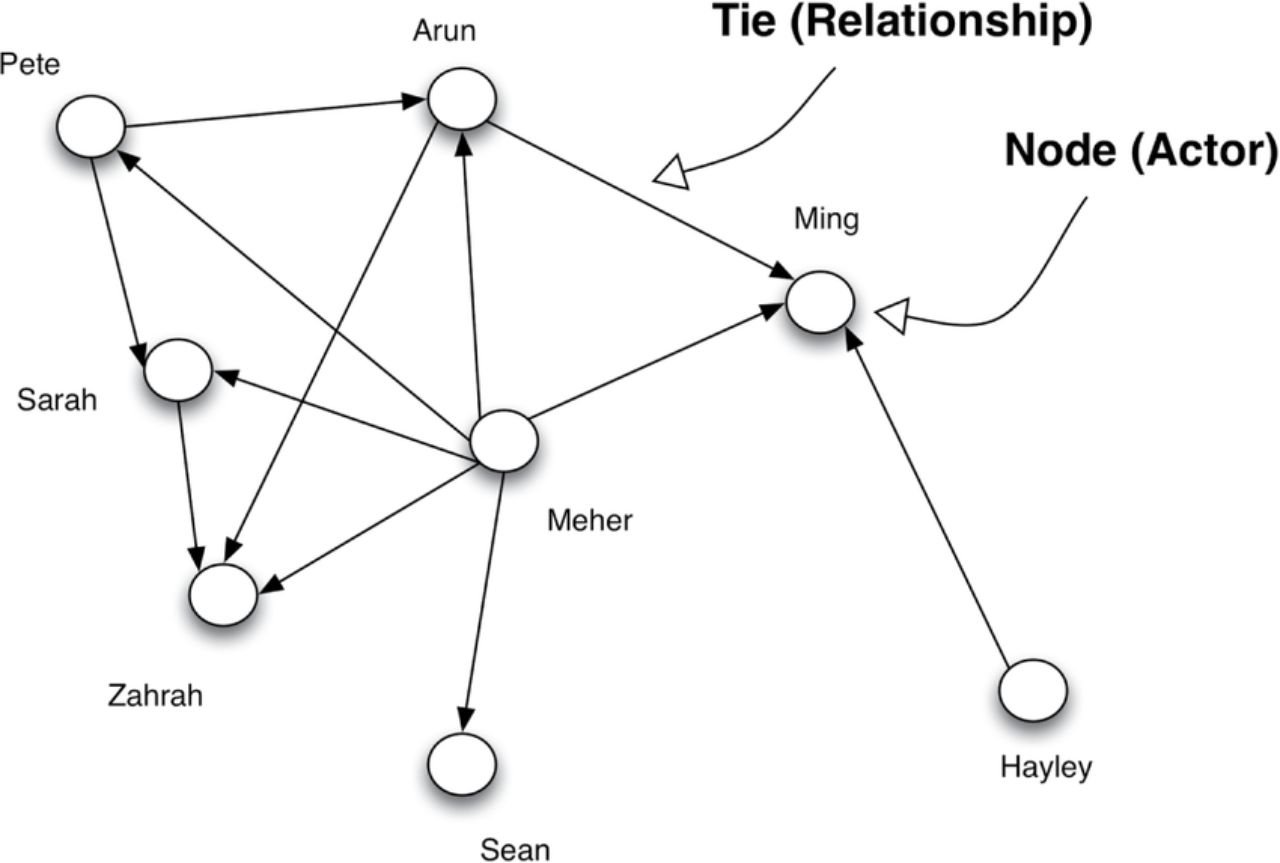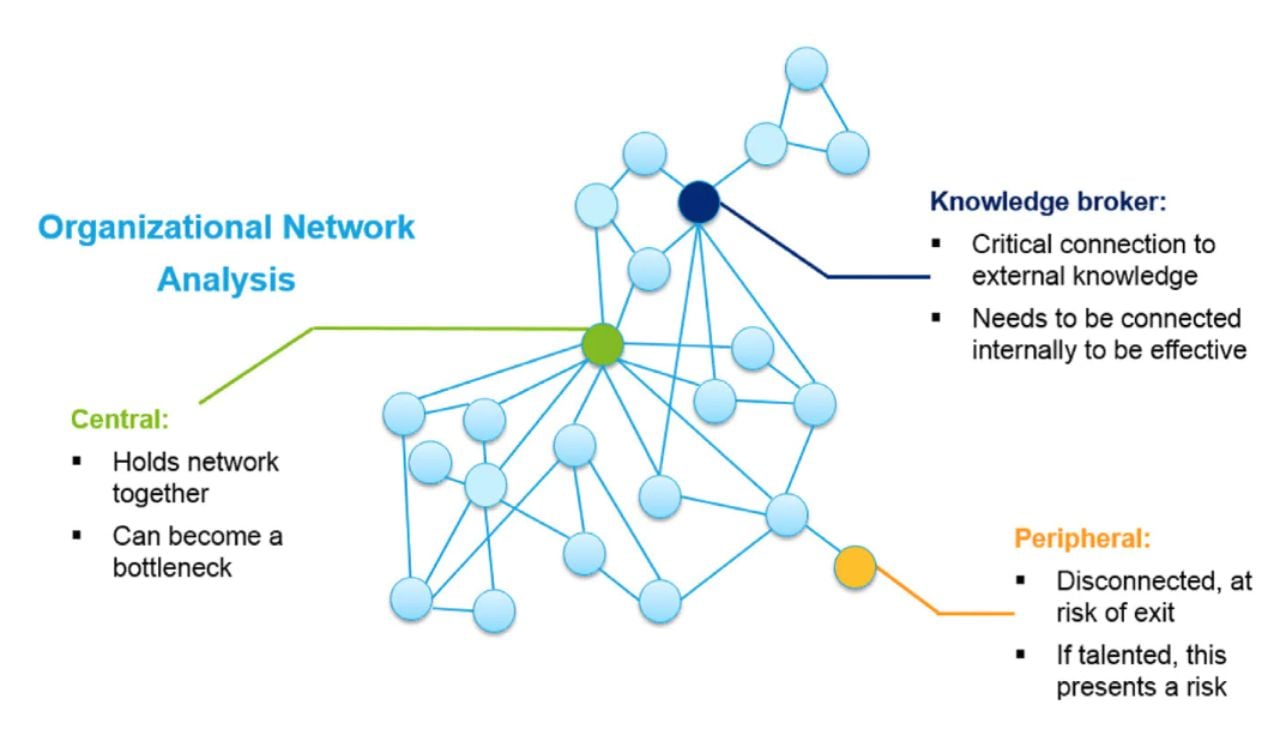Despite the emergence of workplace communication tools like Slack and Zoom, many organizations still struggle to implement effective internal communication.
This can have serious knock-on effects across the business, leading to poor employee morale and reduced productivity. In fact, 70% of people say that communication issues in their business have led to them wasting valuable time while at work.
Thankfully, there are steps that you can take to improve communication and the distribution of information throughout your business. Implementing Organizational Network Analysis (ONA) is one such step.
It can be the key to improving the flow of information within your organization, enhancing collaboration and efficiency as a result.
If organizational network analysis is a totally new concept to you, don’t worry. We’re going to cover the key concepts of ONA, the benefits it can bring, and the best ways to carry it out to bring you up to speed.

What is an organizational network analysis (ONA)?
Organizational network analysis (ONA) is a methodology for investigating how employees interact within your organization. It aims to identify and analyze the socio-technical connections that allow employees to communicate and collaborate.
The origins of ONA can be traced back to social network theory and the sociograms that were first drawn up by sociologists in the 1930s. These were graphical representations of a person’s social network long before Facebook and Myspace popularized it for the masses.

They took shape as a kind of map of the connections a person shares with those around them. Nodes represent different points of contact, with connecting lines showing the relationships between them.
ONA uses this same approach to visualize the invisible connections that allow information to be shared within your organization. By identifying these patterns, it becomes easier to identify and hopefully improve the flow of information.
Benefits of organizational network analysis
Many organizations implement ONA to achieve a variety of goals. Let’s find out some of the main ones.
1. Enhances information flow and collaboration
Implementing ONA allows organizations to improve the flow of information between employees, facilitating more effective collaboration in the process.
Visualizing the connections between employees means that leaders can identify the most effective communication channels used, and any collaboration gaps or information bottlenecks that need to be addressed.
By tackling these, you can make sure that information flows freely and that employees who need to collaborate with one another can do so efficiently.
2. Identifies crucial figures within the organization
ONA is useful for identifying key influencers or informal leaders within your organization. These are people who may not necessarily hold formal leadership positions but who still have significant impact and influence on their peers.
For example, team members who are experts at using communication and collaboration tools such as Trello or Zoom are likely to have made a big impact in the organization recently, thanks to the continuing shift towards remote and hybrid work.
Being able to recognize these individuals means you can strategically leverage their influence and make sure that their knowledge and expertise can be more easily passed on to those who would benefit from it.
3. Leads to better-informed decision-making processes
Implementing strong decision-making processes is crucial to the success of all businesses. The ability to make well-informed decisions typically relies on two factors; access to information and collaboration between different departments.
Access to information allows you to make data-driven decisions; choices that are backed up by historical data and accurate predictions for the future. Making decisions based on data analysis is one of the best ways to achieve success.
The input of different departments is also vital to the decision-making process. It means that as many different viewpoints as possible are considered before deciding on a plan of action.
One department may see potential obstacles due to their expertise that others haven’t considered, so collecting insights from as many different teams as possible gives you the best possible chance of identifying and avoiding roadblocks to success.
4. Improves resource allocation by leveraging network insights
Identifying how information flows through your organization means that the process can be optimized. Strategically allocating resources to where they’re most needed, and will be most effective, can revolutionize an entire communication network.
ONA not only helps to identify key information resources within your organization but can also highlight where these resources would be best deployed to maximize their effectiveness.
This is especially useful when used in combination with budget management software. The ability to track spending and set spending limits allows you to strategically deploy resources in a network in a way that protects your bottom line.
There are plenty of other tools that can help you distribute resources effectively in your organization. For example, a resources management platform such as Katanta helps you to visualize your staffing across all your projects, so you can make sure that every team member is exactly where they need to be.
5. Promotes an innovative culture by strengthening connectivity
Improving communication and collaboration throughout your organization has the knock-on effect of boosting innovation. Bringing together disparate groups with different backgrounds and expertise allows for more creative problem-solving. ONA helps to facilitate this.
Key concepts in organizational network analysis
A deeper understanding of organizational network analysis should help you to realize the benefits we mentioned above. With that in mind, let’s dig into some of the key concepts involved in ONA.
1. Nodes and ties
ONA depicts the individuals or entities in an organization as nodes. A node could represent an individual employee, a team, or an entire department.
Ties depict the formal or informal relationships that connect the various nodes. They represent any connection or interaction between two nodes, including information flow, communication, and collaboration.

2. Network measures
Network measures are the quantitative metrics used to analyze and interpret ONA data. They help to provide tangible insights into the structure and dynamics of the network, as well as its overall health and performance.
Network measures to be tracked could include:
- Density - the number of actual connections in a network compared to the number of possible connections. A high density indicates frequent communication and collaboration, while a low density indicates a more fragmented network.
- Degree centrality - The number of direct ties of each node. A higher-degree centrality indicates a node is highly connected and likely has greater influence and improved access to information.
- Network diameter - The maximum distance, i.e., number of ties, between any two nodes in the network. A high network diameter indicates poor communication efficiency, while a low network diameter likely means that any two nodes can easily connect and share information, regardless of their position in the organization.
3. Network roles
Network roles are the different functions that nodes may perform within an organizational network. They help to classify nodes based on the nature of their connections and can help to quantify the relationships between them.
Commonly seen network roles include:
- Knowledge brokers - individuals who possess a great deal of general knowledge or knowledge about a very specific topic. They are instrumental in building bridges between others in the network and facilitating the sharing of information between them.
- Peripheral nodes - individuals with limited connectivity to the rest of the network. They can be easily overlooked even though they possess valuable knowledge, usually because it has limited relevance to the day-to-day operations of the rest of the network, e.g. Java coders.
Steps for organizational network analysis
How ONA is carried out will vary from one organization to another, but there are several key steps that should always be followed.
1. Establish clear goals and objectives for your analysis
The first step is to outline exactly what you want to achieve with ONA. Having a clear goal in place will help guide your analysis efforts and inform the decisions you make throughout the process.
It’s useful to start with one key question, and then expand outwards from there. For example, “Are there data silos in my organization?” is a great place to start. Of course, “How do I eliminate data silos if I find them?” is an equally important question that you should follow up with.
2. Collect relevant data through various methods
Once your objectives are set, it’s time to start collecting the data that will help you to achieve them. There are a variety of ways you can do this:
- Surveys - The best way to find out how your employees communicate is to ask them directly. Surveys and questionnaires can be used to capture a snapshot of who individuals and teams collaborate with most frequently, and which relationships they perceive to be the strongest.
- Social network analysis (SNA) tools - Specialized tools are available that can access, analyze, and visualize data from email communication logs, collaboration platforms, and your organizational databases.
- Time management tools - These tools can be great for boosting efficiency and analyzing team performance. Software for time and expense management will allow you to see where time is being lost, analyze for any operational gaps, and identify key team members and connections.
3. Create visual representations of the organizational network
Creating an organizational network analysis model is the best way to visualize your results. It provides you with an easy-to-understand representation of the communication networks and relationships within your organization that anyone can look at and draw insights from.

4. Apply appropriate metrics to assess network dynamics
There are a wide variety of metrics you can use to carry out ONA. It’s important to focus on ones that will provide actionable insights in relation to your specific goals.
For example, if your aim is to improve the efficiency at which information is accessed across your organization, a metric such as closeness centrality would be useful to track. But if your aim is to identify and promote key information resources, then a metric such as centrality prestige would be more beneficial.
5. Extract meaningful insights from the analysis
There’s little point in gathering and visualizing all this data unless you're going to draw some relevant insights from it, and then act upon them.
Keep the goals and objectives you set at the beginning of the process at the forefront as you begin to extract value from your data, and specifically look for connections and patterns that answer the key questions of your investigation.
6. Communicate findings and implement plans for improvement
Once you’ve extracted your insights and collected your findings, it’s time to start using them to make improvements. The first step is to share what you’ve found with the relevant stakeholders within your organization.
Any plans you put in place to improve communication will need the support of key figures such as department heads, human resources professionals, and the IT department.
Collaborate with these key stakeholders on plans for improvement, taking into account their unique expertise and ability to spot pain points you might’ve missed. Once you’ve developed a plan that has everybody’s support you can start to put it into action and overcome the negative impacts of poor communication.







Comments ( 0 )